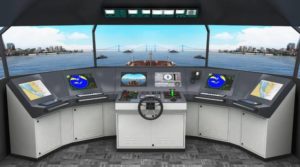
Sailors, captains and pilots may no longer have to travel to the UK or Singapore to get trained on ship simulators. They will be able to acquire this training at IIT-Madras, which will soon launch a 360-degree full bridge simulator.
The simulator will help train sailors in navigating Indian ports and waterways under different conditions, and also help investigate maritime accidents.
Data customisation
Unlike most such equipment, the simulator at IIT Madras will have the facility to customise data, to reflect advances in hydrodynamics and data collection, said K Murali, Department of Ocean Engineering, IIT-Madras, who is also the Nodal Officer of the National Technology Centre for Ports, Waterways and Coasts, which has set up the simulator.The centre works to modernise Indian ports and fast-track waterways under the Centre’s Sagarmala project, an initiative for port-led infrastructure.
Murali said a full bridge ship simulator has real controls of a ship’s bridge and seamless visuals that displays port and the marine environments. It could be used to train people in navigating different kinds of ships through various environments, such as in the port basin, inland ports, sea ports, the deep seas and in rough weather.
Training on the simulator at IIT will cost just one-third of what ports incur on sending officials to the UK, Murali told BusinessLine. Typically, a port’s details are sent to the UK facility, where the official is trained for a particular manoeuvre ““ say, handling a very large crude carrier coming to the port for the first time.
Probing accidents
The simulator, which has been set up in collaboration with the Delhi-based ARI International, will have details of all the major ports in the country. Apart from training mariners, this equipment can also help conduct studies on new ports and investigate maritime accidents. Data on accidents such as collisions and oil spills could be fed into the simulator, along with wind and ocean current information, to find out how an accident occurred.Murali said the ship simulator modelling delivers new and innovative methods of teaching ship manoeuvring and port operations. It could be used to conduct studies such as navigation in open waters, coastal navigation, navigation in high traffic density situations, approaching the harbour, approaching the berth, mooring, berthing, and un-berthing, standard manoeuvring, passage planning, and execution and collision regulations.
The simulator is also suitable for navigation training in different environments, such as night time, poor visibility, heavy rains, strong winds, and severe sea states and strong currents, besides in areas of rapidly changing currents, said Murali.
Boon to Chennai port
Chennai Port Trust Chairman K Raveendran said that with the port’s entire model available, the simulator can be used repeatedly to understand what changes need to be made, before handling a ship or if the port is capable of handling a ship.Last year, Chennai Port handled a Very Large Crude Carrier inside the port basin for the first time by any major port. Usually, due to the huge size, such ships are handled outside and cargo brought on barges. Before the ship was handled at the port, pilots were sent to a private company in Delhi to work on a simulator and check the feasibility of handling the VLCC inside the port basin. A few lakhs were spent on this. This can now be done at IIT Madras at a much cheaper cost, Raveendran added.